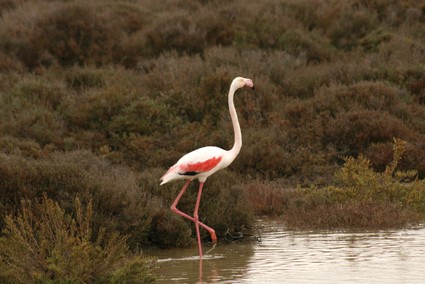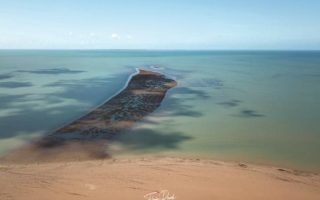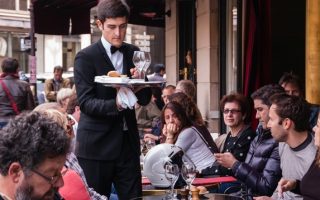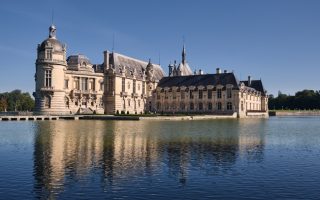Riding in the Camargue

Three hundred and 60 square miles of soggy swamps, sodden marshland and muddy lagoons – if there were crocodiles in Europe, this is where they’d live. The Camargue is western Europe’s largest river delta. Shaped like a huge croissant it’s enclosed on either side by the two arms of the River Rhône. It’s also home to flocks of pink flamingos, nesting storks, white horses, black fighting bulls and, most perilous of all, vicious mosquitoes. It’s mid-April, so the latter are fortunately still in their harmless larva form. But the other native fauna are out in force. I’m astride a particularly frisky Camargue horse, trotting through a field of horned bulls. It’s the first time I’ve been on a saddle for 30 years, and I don’t mind admitting that I’m very nervous. 80-year-old Jacques Bon, local hotelier and cowboy (or gardian, as they are known locally), is riding alongside me. Sporting white trousers, black jacket, black hat and a huge, grey, bushy moustache – which seems to have a life all of its own – he tells me about his 350-strong herd of Camargue bulls. Some are bred for meat, others to fight. But it’s not Spanish-style bullfighting; these animals compete in course Camarguaise, a non-lethal variation of the sport which takes place in special arenas across the region. It features razeteurs, dressed all in white, whose tricky job is to remove tassels, ribbons and rosettes attached to the bulls’ horns – all without getting gored. You could say it’s the French version of rodeo. The season lasts from Easter until September and features around 750 fights. The finest bulls can enjoy careers as long as 15 years. Spanish bulls are also bred in certain areas of the Camargue, but since they’re destined for the traditional corrida bullfights south of the border, their careers are substantially shorter.
THE RELUCTANT EQUESTRIAN
“We don’t go in for the bullfighting where the bull gets killed,” says Jacques, majestically stroking his moustache. “We leave that to the Spanish.” Having introduced us to his well-fed beasts, Jacques decides to show us some of the wilder animals that live on his 500 hectares of land. “We’re going to flush out some wild boars,” he announces, patting his obedient steed. Clicking his heels, he canters off into the thickest of the bulrushes. No such behaviour from my pony who initially ignores my attempts to follow and bends down instead to munch on a lush tuft of grass. After several minutes of rein-pulling and tongue-clicking I eventually persuade him to get moving, not before very nearly parting company with my saddle. Although we fail to spot any boars – perhaps my noisy efforts at equestrianism frighten them all off – there are tracks left by the animals everywhere. This really is one of the wildest (and most sparsely populated) regions of France. It’s hard to believe that the great metropolises of Marseille, Montpellier and Nîmes are just a few miles away. It’s so barren that much of the area has been devoted to the Parc Naturel Régional de Camargue, home to over 500 species of native and migratory birds. Bored of the boars, Jacques takes us back to his hotel, Le Mas de Peint, and shows us around his estate. The beautiful 17th-century farmhouse, where he was born and has spent his entire life, has been converted into an eight-bedroom hotel under the direction of Jacques’s wife, Lucille, a former architect. So impressive is the kitchen that even Gordon Ramsay might cease his swearing for a minute if he saw it. Across the courtyard is a huge sheep barn, now converted into a 750-square-metre dining-hall cum meeting-room; big enough for two tennis courts end to end. In an adjoining room, Jacques has displayed framed photos of his family in traditional Camarguais dress. One by one he proudly points out the offspring he has sired. This cowboy has sons and daughters ranging from their 20s to their 50s. I ask him if there’s something special in the water in these parts. He just winks at me.
CREATURES FROM THE LAGOON
Breeding is also fundamental to the next person I meet in the Camargue. Jean-Christophe Briffaud, park ranger in the Parc Naturel Régional de Camargue, is in charge of all the birds nesting in his park. With binoculars the size of anti-aircraft guns, he points out various species feeding, swimming and swooping down on the water. But there’s only one species I want to see: the pink flamingos. These gangly animals stand knee-deep in the marshes, searching in the mud for the crustaceans that give their feathers that special hue. Stationary, they look fairly awkward and uncoordinated. But as soon as you get too close they break into flight, flapping their huge wings furiously, in unison, and tip-toeing fast across the surface of the water in what looks like an impossible attempt to beat gravity. Once in full flight they look majestic, with their necks stretched out front and legs tucked aerodynamically behind. Remember the opening credits to that 1980s show Miami Vice? With the Camargue marshes as a backdrop and these splendid flamingos flying across the horizon, you could almost be in the Florida Everglades.
Between 7,000 and 8,000 baby flamingos are born here every year. That afternoon I drive to one of the few towns within the Camargue – Les Saintes-Maries de la Mer. Locals here say the area has three seasons: sun, wind and mosquitoes. The day I visit it’s the season of wind. What feels like a force-eight gale is blowing in off the Mediterranean and buffeting me against the tiny bungalows that line the streets here. No wonder this is the spot where, a few years ago, the world speed record for windsurfing was set. For respite I shelter in the beautiful old medieval church in the middle of town. Every year, towards the end of May, this building becomes a mecca for Europe’s Romany gypsies. According to an old Provençal legend, in biblical times the patron saint of gypsies, Sarah (along with Mary Magdalene, Mary Jacob and Mary Salome), fled the Holy Land in a tiny boat and ended up making landfall here, near the mouth of the River Rhône. Hence the name ‘Les Saintes-Maries de la Mer’. In the 1400s locals dug up what they believed were the remains of these saints. Romany gypsies (or gitans) have been making the annual pilgrimage here ever since, often as many as 12,000. With their caravans and traditional gypsy clothing, they dance and play music in the streets, carrying a statue of Sarah. Quite a party. That night I stay in a beautiful hotel on the outskirts of Les Saintes-Maries called Les Arnelles. With working stables attached, it features rooms built on huge pontoons across the lagoons. As the sun goes down, electric lights blink on, all along the pontoons, and the image of the hotel is reflected in the water. Being April it’s still the season of wind. In just a few weeks locals will be experiencing the other two harsh seasons of Les Saintes-Maries: sun and mosquitoes.
Share to: Facebook Twitter LinkedIn Email
Leave a reply
Your email address will not be published. Required fields are marked *



